2013 Ford Mustang Shelby GT500 Convertible
If you want the best, look no further than the 2013 Ford Mustang Shelby GT500 Convertible.
Connoisseurs of street machines will be enthralled with this
convertible. It truly lives up to the name on the package and represents
everything that Shelby stood for when building their vehicles.
Ford has redesigned the SVT Cobra to the point that this surpasses
all others with the Shelby Performance package offered over the last 20
years. It is difficult to get the feel of this vehicle without seeing
all that it offers however you will be left breathless when you see it.
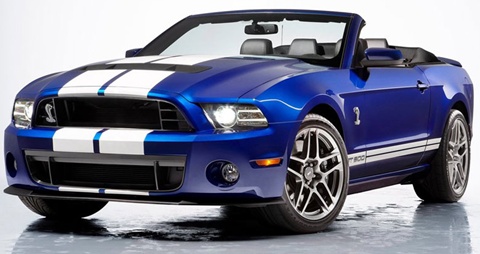
Performance
This twentieth anniversary model has come a long way from the days of
235 HP 5.0L engines as this baby packs a spectacular 650 horsepower,
leaving the competition in the dust. Do not let the new Mustang Shelby
GT500 Convertible scare you away.
This super charged 5.8 liter ragtop is as powerful as the hard top
coupe and considering the lighter weight, it exceeds all expectations
when it comes to performance and handling.
Handling
Right off the bat you will notice adjustable dampers that allow for
exceptional performance in combination by tuning the chassis with
different modes available at the touch of a button. Whether the road is
smooth or rough, you are assured that it will handle with pure
excellence.
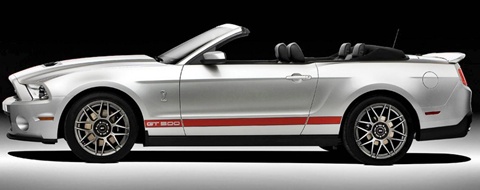
More
This model has the most powerful engine in its class as well as 20
years of advances in engineering that have finally led to the perfect
SVT Cobra. From its muscle car looks to perfect handling and
performance, the 2013 Ford Mustang Shelby GT500 Convertible is one to
consider and easily the foundation for a new generation of sports cars
and a collectible for any muscle car enthusiast
2012 Ford Mustang Cobra Jet Twin-Turbo Concept
Since the debut of the Cobra Jet in 2008, it has been one of the most successful, production-based racing vehicles in the world.
The 2012 Ford Mustang Cobra Jet Twin-Turbo Concept, is
turbo-charged technology at its best and is taken from the production
EcoBoost engines with the aim of enhancing performance.
This 2012 Concept comes with an improved suspension, revised interior, new design elements, and an upgraded engine.
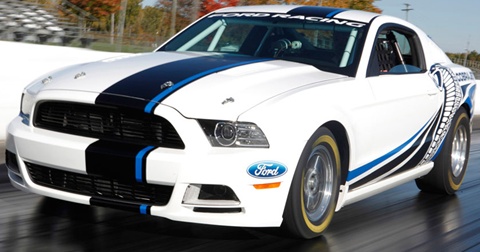
Engine
Under the hood is a twin-turbo engine, revised from the 5.0 L V8
engine of Ford. A 2.9L supercharger is linked, drawing up to 100 hp from
the drive train to increase the power that can be used.
The engine is helped by a 3-speed C4 Auto Race gear-box, the
combination enables the Jet to produce 430 horsepower. This power is put
into use through the help of a drag race tire/titanium aluminized
wheels combination. Light-weight low-drag brakes help slow and stop this
Mustang.
Exterior
Initial details suggest that the car will be fitted with black
anodized wheels as well as new optional finishes of Grabber Blue, Race
Red and Winner White. However, the exterior will be offered in a
standard Crisp white finish combined with black and blue strips that
runs from the front bumper through the top of the car to the rear
bumper.
A graphics package is available as an option and includes: 5.4 Cobra
Jet hood graphics, Power-By-Ford fender emblems and Sweeping Snake side
graphics among others. The automaker will also fit the 2012 model with
an 8.50et NHRA certified roll cage for maximum safety of the occupants.
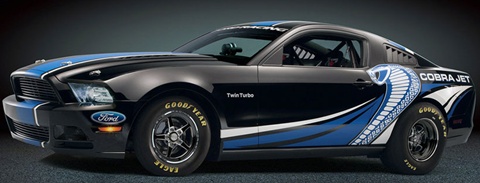
Other key features expected on the Twin-Turbo Concept include: Watson
engineering stainless-steel-headers, anodized and forged pistons with
Grafal-coated skirts, Livernois Motorsport valve springs and Manley
H-beam connecting rods.
The new Twin-Turbo is still in its concept stages; it is yet to be
tested and finalized before actual production takes place. However, with
the little information we know, this 2012 Twin-Turbo Concept may have
the competition quaking in their boots. It will face competition from
rivals like Nissan’s 370Z coupe, the Dodge Challenger and the Chevrolet
Camaro Coupe.



Most Expensive Cars In The World: Top 10 List 2012-2013
The 1931 Bugatti Royale Kellner Coupe was sold for $8.7 million in
1987. That and many others won’t be included in this list, they are no
longer available in the market.
If you can afford it, you would probably invest a small fraction of
that on a bevy of supercars for your garage. Here are 10 of the most
expensive street legal production cars on the market (at least 2
available); concept cars are not included.
World's Most Expensive Cars:
1. Bugatti Veyron Super Sports $2,400,000.
This is by far the most expensive street legal production car available
on the market today (the base Veyron costs $1,700,000). Capable of
reaching 0-60 mph in 2.5 seconds, the Veyron is the fastest street legal
car when tested again on July 10, 2010 with the 2010 Super Sport
Version reaching a top speed of 267 mph. When competing against a
Bugatti Veyron, you better be prepared!
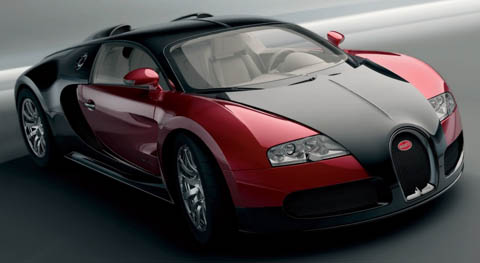
There is a tie for #2!
2. Aston Martin One-77 $1,850,000.
The name "One-77" says it all: beauty and power in One, limited to 77
units. With 750 hp, it is able to travel from 0 to 60 mph in 3.4 seconds
and reaching a maximum speed of 220 mph.
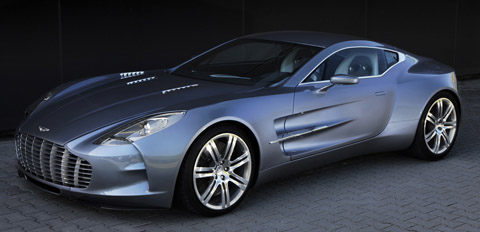
2. Pagani Zonda Cinque Roadster $1,850,000.
One of the most exotic cars out there is also one of the most
expensive. It can go from 0-60 mph in 3.4 seconds with a top speed of
217 mph. 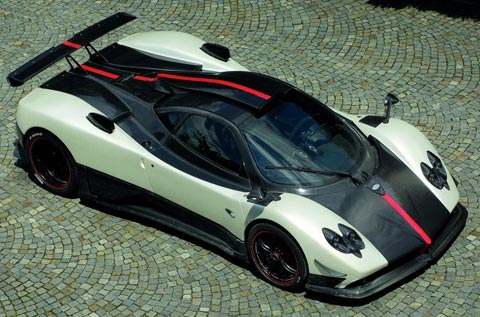
We have another tie for 3rd place:
3. Lamborghini Reventon $1,600,000. The
most powerful and the most expensive Lamborghini ever built is the
third on the list. It takes 3.3 seconds to reach 60 mph and it has a top
speed of 211 mph. Its rare (limited to 20) and slick design are the reasons why it is expensive and costly to own.
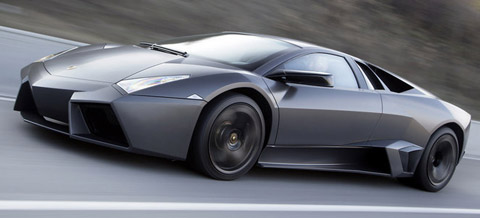
3. Koenigsegg Agera R $1,600,000.
The Agera R can burn 0-60 mph in 2.8 seconds, reaching a maximum speed
of 260 mph. It is equipped to reach 270 mph, but the supercar is
electronically limited to 235 mph. You will need to sign a waiver, only
then does the company unlock the speed limiter for a given occasion. 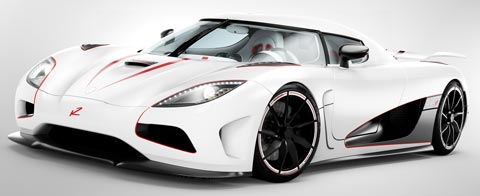
4. Maybach Landaulet $1,380,000.
The Landaulet is the most expensive sedan on the market and it can go
from 0-60 mph in 5.2 seconds. It is one the most luxurious cars ever
made, this comes with a convertible roof that fully opens at the rear.
This Maybach is made especially for CEOs and Executives who have their
own personal driver.
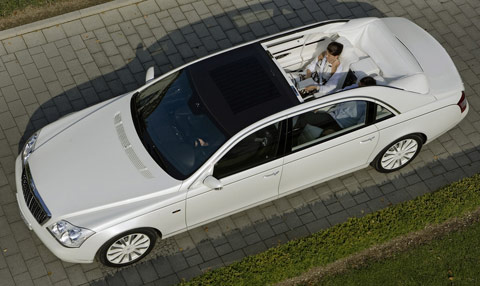
5. Zenvo ST1 $1,225,000. Able to
reach 60 mph in 2.9 seconds and a top speed of 233 mph. The Zenvo ST1 is
from a new Danish supercar company that will compete to be the best in
speed and style. The ST1 is limited to 15 units and the company even
promised "flying doctors" to keep your car running.
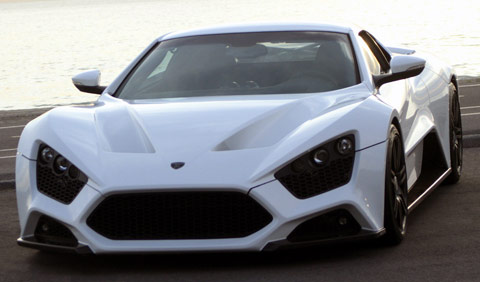
6. Hennessey Venom GT Spyder $1,100,000.
What makes the 2013 Hennessey Venom GT Spyder is its price tag, a
compelling 1.1 million dollars. There is no other convertible in the
world today that can match-up with this car. Not to mention that it goes
from 0-60 mph in 2.5 seconds.
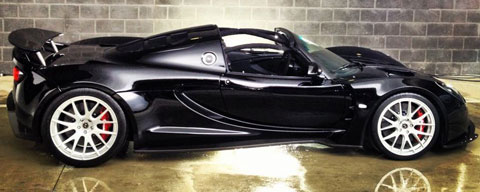
7. McLaren F1 $970,000.
In 1994, the McLaren F1 was the fastest and most expensive car. Even
though it was built more than 15 years ago, it still has an unbelievable
top speed of 240 mph and reaching 60 mph in 3.2 seconds. Even today,
the McLaren F1 is still top on the list and outperforms other supercars.
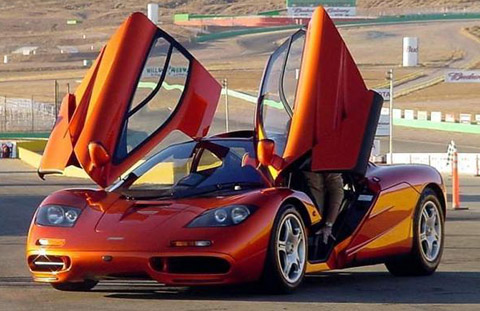
8. Ferrari Enzo $670,000.
The most popular supercar ever built. The Enzo has a top speed of 217
mph and able to go from 0 to 60 mph in 3.4 seconds. Only 400 were
produced and it is currently being sold for over $1,000,000 at auctions.
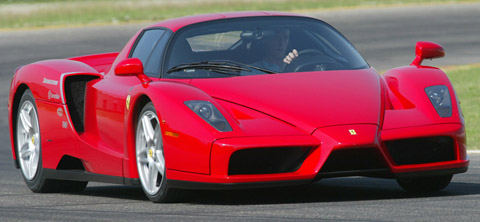
9. Pagani Zonda C12 F $667,321. Produced
by a small independent company in Italy, the Pagani Zonda C12 F is the
8th most expensive car in the world. It promises to deliver a top speed
of 215 mph and go from 0-60 mph in 3.5 seconds.
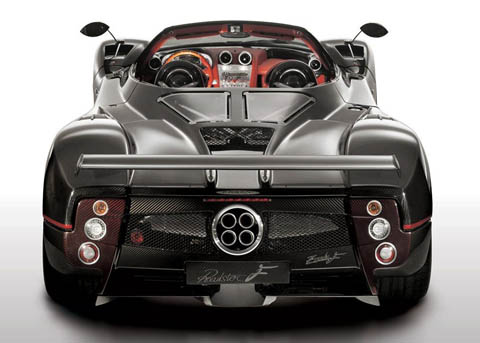
10. SSC Ultimate Aero $654,400.
Don't let the price tag fool you, this American made car is actually
the 3rd fastest street legal car in the world with a top speed of 257
mph and reaching 0-60 mph in 2.7 seconds. It costs less than half as
much as the Bugatti Veyron, yet has enough power to compete against the
most expensive car. It is estimated that only 25 of this exact model
will be produced.
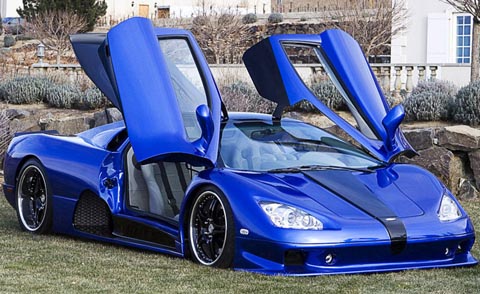
2013 G-Power BMW G1 V8 Hurricane RS
The 2013 G-Power BMW G1 V8 Hurricane RS is a modified version of the BMW 1 M Hurricane and the latest vehicle to be customized by G-Power.
G-Power is the leading supplier of supercharger systems for BMW
engines, and has tailor-made the supercharger for the M3 engine. They
have mounted the centrifugal supercharger from ASA, the T1-523, directly
on the engine.
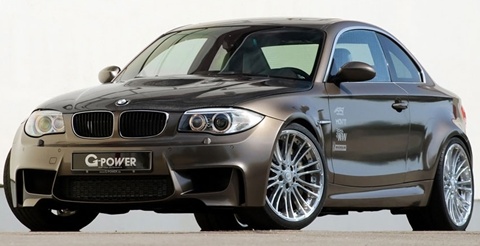
Specifications
| Vehicle Type: Super Sport Coupe | Est. Market Price: NA |
| Fuel Tank Capacity: 14 gallons (53L) | MPG: NA |
| Length: 172.2 in. (437.3 cm) | Wheelbase: 104.7 in. (265.9 cm) |
| Height: 55.9 in. (141.9 cm) | Width: 71 in. (180.3 cm) |
| Curb Weight: 3362 lbs (1525 kg) | Ground Clearance: NA |
| Luggage Capacity: 10.0 cu ft | Maximum Seating: 2+2 |
| Engine: Supercharged V8 | Displacement: 4.0 Liter |
| Horsepower: 600 HP | Torque: 428 lb-ft |
| Transmission: 6-Speed Manual | Top Speed: 205 mph (329 km/h) |
Engine & Performance
G-Power has replaced the standard BMW M1 engine and gearbox with the engine and gearbox from the BMW M3 that are bigger than those in the M1 model. In addition, they modified the M3 engine, and the end result is a supercharged engine that generates up to 600 horsepower, 428 pounds-feet of torque and can achieve a top speed of more than 205 mph, making it the fastest car in its class. From a standing start, the car can reach 125 mph in just under 13 seconds.
Supercharger
The supercharger features an air box manufactured from cast aluminum. This houses a large air filter along with a water based cooling system that allows the supercharger to function at optimal temperature.
The net result of fitting the supercharger to the engine is an increase of 40% in torque. The system also results in the engine running efficiently, thereby reducing fuel consumption.
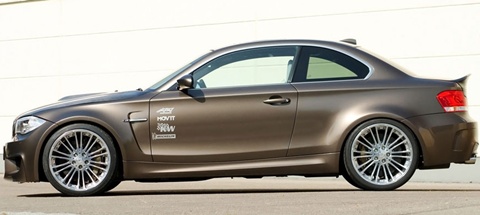
Braking & Suspension
Capable of astonishing speed, it is vital to ensure that the tires, suspension and braking performance of the BMW G1 V8 Hurricane RS are able to cope with all that power.
G-Power opted for Pilot Super Sport tires developed by Michelin, its technology partner, and sourced its braking system to Movit.
The company worked closely with KW to develop a suspension package it calls Clubsport, specifically designed for the G1 V8 Hurricane RS. The task was to come up with a package that allowed for comfort and stability in normal driving conditions while at the same time providing the stability, comfort and control required on a race track, and they have succeeded in doing this in the 2013 G-Power BMW G1 V8 Hurricane RS.



Ford EcoSport
Audi A3 Pencilled Price
The A3 sedan will be approximately the same size as the VW Vento and the Skoda Rapid, but will understandably be far more plush, with a full multimedia suite on the inside and premium feel materials. Of course, you also get four rings on the grille rather than a simple VW logo. Audi is keen to point out that with the A3 it wants the brand to appeal to younger buyers, and so the full multimedia experience, along with large touch-screen interface, is a key part of the car’s features.
New Hyundai Santa Fe
WHEN: Mid – 2013HOW MUCH: Rs 25 – 30 lakhENGINES: 2.0-litre diesel (150 PS, 382 Nm), 2.2-litre diesel (200 PS, 431 Nm), 2.4-litre petrol (193 PSP, 245 Nm)
The new Hyundai Santa Fe has just been revealed. This third-generation model of Hyundai’s popular SUV will go on sale worldwide by the end of this year, and is set to reach Indian shores in the first half of 2013. Read on for more details.
The Hyundai Santa Fe first made its debut in 2000. Since then, it has gone on to sell over 2.5 million units globally. The second-generation Santa Fe made its Indian debut in 2010, and even in our market it out-sold even Hyundai’s own conservative estimates. The Santa Fe, along with the Sonata saloon, has gone a long way in establishing Hyundai’s reputation as a maker of quality cars.
The new Santa Fe was revealed at the New York Motor Show recently. This third-generation model has been styled using what Hyundai calls ‘Storm Edge’, which is an evolution of its ‘Fluidic’ design architecture. The usual Hyundai design clues, including a bold hexagonal front grille and stylised, multi-dimensional headlights are found on the new Santa Fe as well. A strong character line runs the length of the car, and incorporate the door handles. This crease too is found on all of Hyundai’s latest models, including the new Verna and Sonata, and the upcoming new Elantra.
The new Hyundai Santa Fe is longer, wider and lower than the present model, although the 2,700 mm wheelbase remains unchanged. A combination of steel and aluminium for the construction has ensured that the new Santa Fe is lighter as well. The Santa Fe’s chassis utilises car-like suspension layout, comprising of McPherson struts up front and a multi-link rear, with gas-filled shock absorbers all-round. A host of electronic over-rides ensure that the Santa Fe remains well planted on the road. Although the Santa Fe does boast of four-wheel drive, it is not a true-blue off-roader. For most everyday use, 100% of the tractive power is sent to the front wheels, with an electronically-controlled differential sending power to the rear wheels when it detects slippage. The driver does have the option of engaging the all-wheel drive system manually, which splits the torque between the front and rear axles 50:50, but this system is usable only up to 40 km/h. The Santa Fe does not have the option of a low range either.
Three engines are on offer, which include the option of 2.0-litre or 2.2-litre diesel engines, or the 2.4-litre GDi petrol unit found under the bonnet of the new Sonata. The 2.0-litre diesel is available only with a 6-speed manual gearbox, while the 2.2-litre diesel and 2.4-litre petrol are available with the option of a 6-speed automatic as well. Four wheel drive is optional on all three engine variants. Hyundai claims the 2.2-litre diesel is the cleanest in its class, emitting just 145 grammes of CO2 per kilometre. The 2.2-litre diesel with a variable geometry turbine already does duty in the current model of the Santa Fe as sold here, and logic dictates that it will be the engine that Hyundai would once again choose for the new model when it comes to India. However, it is important to note that the choice of engine is critical, because it could hold clues about which engine Hyundai chooses for the Sonata in the future. Also, Hyundai could consider offering the petrol version as an option to customers, even though volumes would be understandably low.
The new Santa Fe is available with a very high specification of features, which is something customers have come to expect of Hyundai. The well-appointed interiors feature a panoramic sunroof, automatic headlights and wipers, radar-activated cruise control, a 7-inch touchscreen infotainment system, and a full suite of electronic driver aids, including HAC (Hill Assist Control), DBC (Downhill Brake Control), VSM (Vehicle stability management) etc. The Santa Fe will continue to have seven seats, with the option of folding the third row flat into the floor.
Prices for the new Santa Fe haven’t been declared, but this new SUV will be on the market in Europe and North America by the end of this year. Like we said earlier, India is set to get the new Santa Fe sometime next year. Whether Hyundai will assemble the new Santa Fe in India, or import it fully as it does the current model, hasn’t been decided, but Hyundai’s Indian officials have confirmed that the new Santa Fe is definitely on the cards for an India market launch in 2013.
New Chevrole Cruze
On the styling front, the new Cruze gets a revised front bumper, front grille, fog lamps and a new chin. It's still instantly recognisable though. The front two-part grille now has a deeper, more pronounced lower section, with horizontal slats replacing the earlier honeycomb mesh. The front fog lamps have been integrated into triangular nacelles, which together with more pronounced chin give the new Cruze a much more aggressive face.
At the rear, the tail lights will do away with the round elements within the lenses, replaced by more angular designs. New look aloy wheels complete the styling changes with a flourish.
GM has also upgraded the Cruze's engine, and power now jumps from 150 PS to a lofty 166 PS. Despite the increase in power, the company has worked hard to make the Cruze more drivable. While no doubt the Cruze has always enjoyed stonking performance, the huge turbo lag meant that accessing the power was tedious, especially in traffic, with a huge surge when the turbo spools up. Chevrolet assures us that the new car is much more drivable, and that its engineers have worked hard to address this criticism. Special attention has been paid to the Cruze's NVH characteristics, with new sound deadening material being used for the bulkhead and under the floor.
Chevrolet will launch the new Cruze in the Indian market sometime in end June or early July. Prices will be revised slightly upward, to the tune of Rs 60,000 or so. Three variants will be available, which include the Cruze LT manual, Cruze LTZ manual, and the Cruze LTZ AT, with a six-speed automatic transmission. The Cruze currently enjoys a strong position in the Executive Sedan segment, considering it is the only diesel automatic at the price (the Laura AT is much more expensive) and Chevrolet India wants to milk this to the maximum.
Mercedes CLS 350 Specification
The long right-hander ahead stretches as far as I can see. Almost subconsciously, I pile a bit more pressure on the throttle. The suspension hunkers down, the rear wheels bite the tarmac a little bit harder and, apart from the increase in pace, everything remains completely calm inside the cabin. What’s immediately clear is that, though this car is based on the current E-class, the new CLS delivers a driving experience that surpasses its donor. The nearly 2.9-metre wheelbase and wide footprint give it amazing stability around longer corners, and once settled into the bend, the near-five-metre length and 1735kg kerb weight seem to somehow shrink. The Airmatic suspension lowers the ride height, the suspension gets a bit stiffer when you select Sport, and the already impressive body control tightens up even further.
The direct, electromechanical steering is lacking in feel, but it is very precise and that makes it easy to place the immense CLS in a corner quite easily, even at triple-digit speeds. However, more weight and feedback would have been welcome. Through sharper corners, it becomes apparent that the CLS is no lightweight supercar. Push it hard and the rear-wheel-drive car understeers and the ESP cuts in rapidly. Get carried away and take your eyes off the clocks, and you’ll find yourself at speeds worryingly close to the two-tonne mark. Which is why more bite and feel from the first few millimetres of brake travel would have been nice too.
It may be called a 350 like the E-class, but this motor is different. Developing a much healthier 306bhp and 37kgm of torque this creamy-smooth, direct-injection engine has ample torque right from 1500rpm. In many cars, the message from the accelerator seems to pass through a government agency and a translation service before reaching the engine. But in the CLS the right pedal and the motor seem to be connected via ESP (Extra-Sensory Perception). A light dab of the accelerator sends the CLS rolling forward smoothly. Press down with greater urgency and the motor hauls you forward briskly, and like all very torquey motors, the resulting change often pins your head to headrest. The 7G-tronic gearbox, however, is a bit slow on the downshift and using the paddles can be a bit frustrating at times. All put together, the CLS manages 0-100kph in a claimed 6.95 seconds, which is plenty quick.
Back in 2004 I dismissed the first-generation CLS as unnecessary and frumpy. But that was only until I saw it in the metal. After that I promptly fell hopelessly and nonsensically in love with it. Mercedes’ second take on the four-door coupe design is also a bit hard to swallow. Although this time, I’m giving it a more patient hearing. The new C218 CLS is attention grabbing, albeit in a technical and futuristic manner. While the last CLS’ design could be represented with just a few light strokes, the new CLS has a frenzy of highlights and a barrage of hectic lines. There is plenty of muscle here and the low roof, tight-fitting boot and the LED lamps give it a presence you just can’t ignore, and that’s just what Merc wants. Taking it easy in the CLS is quite rewarding too. In Comfort mode, a thick carpet seems to cushion the ride and passengers are not tossed around. However, some thuds over deep ruts do reveal an underlying stiffness, but that is only to be expected.
Passengers won’t feel short-changed in the CLS either. It exudes a dignified ambience, the rear seats are sculpted to feel almost like bucket seats, and though there is space only for two in the rear, this is a genuinely usable backseat that offers great underthigh support. It doesn’t hurt that the CLS has almost the same amount of legroom in the rear as an S-Class either. However, headroom is in short supply and the low roof demands some dexterity when getting in or out.
While it can be argued that the new CLS can’t top its predecessor for sheer class, there is no doubt it is a much better car. It is very attractive to look at, very quick both in a straight line and around corners, and it is very comfortable and very refined as well. It is beautifully built, will stand out as something special in any parking lot and the Rs 71.1-lakh (ex-showroom Mumbai) price isn’t too bad either, considering this car looks like it could cost upwards of a crore. Wish you could buy it with a diesel though.
Fact File
| Ex-showroom price | Rs 71.1 lakh, (ex-showroom, Mumbai) |
| Fuel | Petrol |
| Installation | Front, longitudinal |
| Type | 6-cyls in-vee, 3498cc |
| Power | 306bhp at 6500rpm |
| Torque | 37.7kgm at 3500-5250rpm |
| Power to weight | 176.4bhp per tonne |
| Gearbox | 7-speed automatic |
| Length | 4940mm |
| Width | 1881mm |
| Height | 1416mm |
| Weight | 1735kg |
| Tyres | 245/45R 17 |
| Front | MacPherson |
| Front | Vented discs |
| Rear | discs |
| Tank size | 89 litres |



















